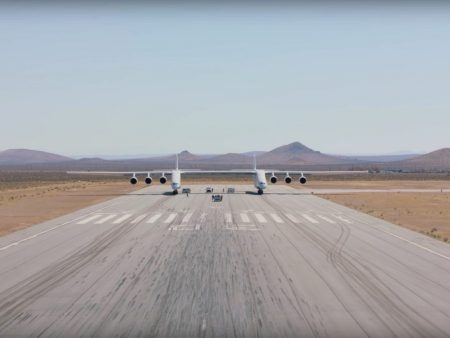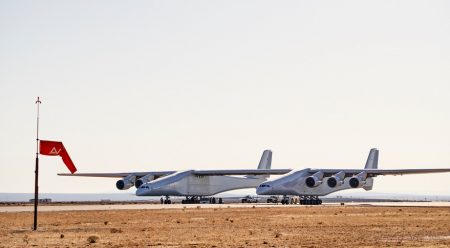March 1, 2018 – The largest airplane on the planet is getting ready to roll. Called Stratolaunch, it is another one of the aerospace creations that has come from tech entrepreneurs turned into space nuts. These include Elon Musk with SpaceX, Jeff Bezos with Blue Horizon, and now Paul Allen (of Microsoft fame). All are in a race to make reusability work to lower the cost to get to space.
Allen has gone a different route from his entrepreneur competitors. He is banking on Stratolaunch, an enormous twin-hulled aircraft to become a primary launch system for those wanting to get into space. Stratolaunch has wings that span 117.35 meters (385 feet). it weighs 226,796 kilogram (250 U.S. tons). And each of its twin fuselages stretches 72.5 meters (238 feet).
In the latest test drive the giant aircraft, seen on the runway below, powered up and taxied at speeds of up to 74 kilometers per hour (46 miles per hour) in the first of what will be a number of pre-flight ground tests to evaluate steering and braking systems.
Considering the size of the aircraft it’s a wonder it didn’t split in two as it rolled down the tarmac weighing 250 U.S. tons (226,796 kilograms).
Allen hopes to make Stratolaunch the most affordable way to deploy large payloads into low-Earth orbit.
The aircraft will fly out of a 3.6-kilometer (2.2-mile) runway. The plan is to strap a rocket carrying a single or multi-satellite payload under the central boom joining the two fuselages. The rocket would then be carried to heights of 9,100 meters (30,000 feet) and released to fire from there into Earth orbit.
The rocket currently under consideration for a future launch is the Orbital ATK Pegasus XL. The Pegasus XL was designed as an air-launched rocket and has flown 29 successful satellite delivery missions. There is sufficient room on the Stratolaunch central boom to hang three Pegasus XL rockets. It will be interesting to see if forthcoming launches, as early as 2019, involves multiple payloads.
Allen may also develop a proprietary launch rocket for Stratolaunch. The company is using NASA sites to test its own rocket propulsion technology.
Will Allen’s dream produce a commercial success? Years late and over a half-billion dollars invested, Stratolaunch is now in a race to compete with the reusable rockets of his two entrepreneur competitors. And he is also facing competition from Richard Branson’s Virgin Galactic which is developing a similar launch strategy using rockets strapped to high-flying aircraft.
Ultimately, Stratolaunch has to prove that its technology works and that it can make the cost of getting to space even less than a growing list of competitors. Last year Steve Nixon, VP for Strategic Development at Stratolaunch, at a June conference stated, “With one aircraft sortie, you could basically launch an entire architecture of satellites into multiple planes, assuming each launch carries multiple satellites.” As impressive as that sounds, the current trajectory of SpaceX launch activity is well on the way to do much the same thing with plans for a 24-hour turnaround in refurbishing and refueling its latest versions of the Falcon 9.


















